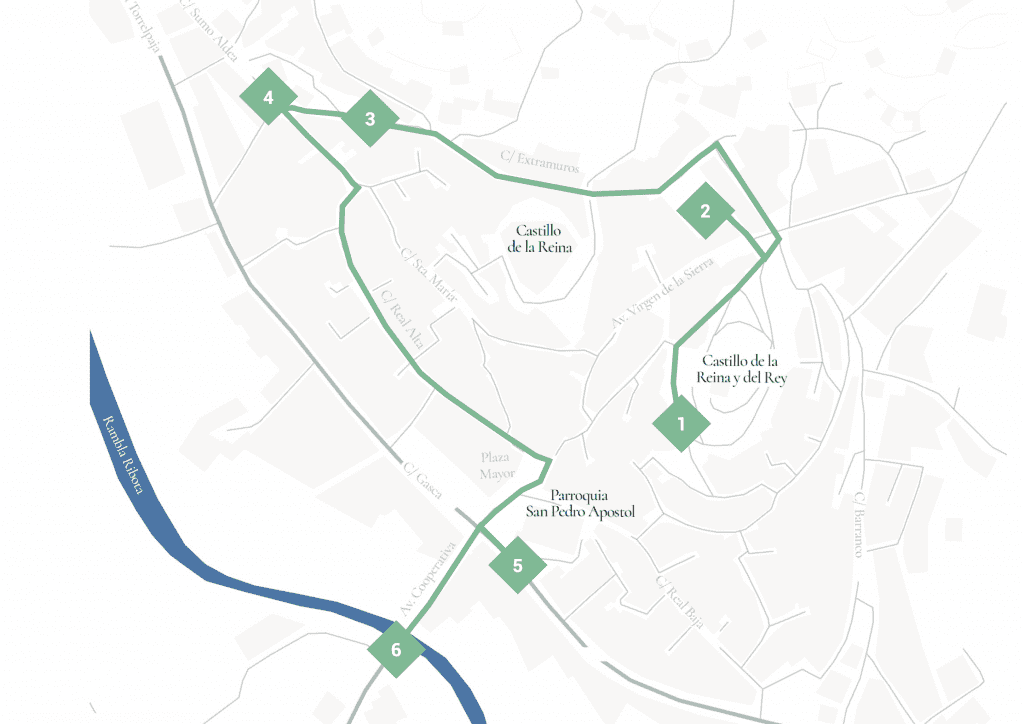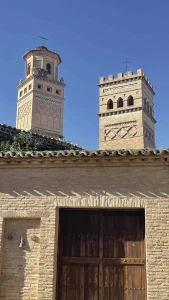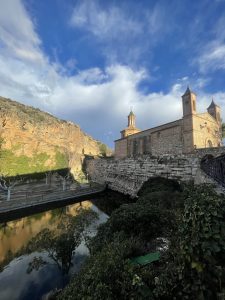

Circular from the rural school
Family Outings

Mudetrad

Didactic Mudejar, the guide

The "villa roya"
Villarroya de la Sierra, the “reddish village” due to the dominant colour of its surroundings, is located at the foot of the Sierra de la Virgen, with all its hamlets on a slight slope towards the river Ribota. There is evidence of settlements from ancient times.
During the Islamic period, the use and cultivation of the territory became evident with the development and improvement of hydraulic engineering systems, construction systems and urban planning.
The town played a fundamental role during the border wars against Castile, as it had an important fortified enclosure of which we still have evidence today: the two defensive towers known as the Castillo de la Reina and Castillo del Rey (Queen’s and King’s Castle) guarded a walled enclosure of which the Low Gate and the Old Gate, of Mudejar appearance, are preserved, as well as a large stretch of wall made of rammed earth.
The castle of the Queen, probably of Muslim origin, dates from the 10th and 11th centuries; and the King’s castle was built with the growth of the city during the Aragonese rule at the end of the 13th century.
Villarroya de la Sierra, the “reddish village” due to the dominant colour of its surroundings, is located at the foot of the Sierra de la Virgen, with all its hamlets on a slight slope towards the river Ribota. There is evidence of settlements from ancient times.
During the Islamic period, the use and cultivation of the territory became evident with the development and improvement of hydraulic engineering systems, construction systems and urban planning.
The town played a fundamental role during the border wars against Castile, as it had an important fortified enclosure of which we still have evidence today: the two defensive towers known as the Castillo de la Reina and Castillo del Rey (Queen’s and King’s Castle) guarded a walled enclosure of which the Low Gate and the Old Gate, of Mudejar appearance, are preserved, as well as a large stretch of wall made of rammed earth.
The castle of the Queen, probably of Muslim origin, dates from the 10th and 11th centuries; and the King’s castle was built with the growth of the city during the Aragonese rule at the end of the 13th century.
A historic urban fabric
The town grew in population and a new neighbourhood was formed to the east, today Virgen de la Sierra street. It also had a new church as a place of worship, which would be located on the site of the current parish church, but of smaller dimensions. The houses of the local bourgeoisie and nobility were transformed to adapt them to the tastes of the time, giving them more space along Calle Real.
The church of San Pedro Apóstol, declared an Asset of Cultural Interest, was built at the end of the 15th century, although its current appearance is the result of a thorough renovation in the 17th century.
Particularly striking is the fusion of building styles, combining the brickwork of the Islamic tradition maintained in the Christian period through the Mudéjar style and the Western European styles present in the Gothic style doorway, belonging to the original building from the beginning of the 15th century.
Another significant area for the locality is the old dula. A dula is the name, of Arabic origin, given to the communal grazing land for the flocks or herds of the neighbours. From this meaning it would make sense to use it as a bullring in the case of Villarroya de la Sierra.
The town grew in population and a new neighbourhood was formed to the east, today Virgen de la Sierra street. It also had a new church as a place of worship, which would be located on the site of the current parish church, but of smaller dimensions. The houses of the local bourgeoisie and nobility were transformed to adapt them to the tastes of the time, giving them more space along Calle Real.
The church of San Pedro Apóstol, declared an Asset of Cultural Interest, was built at the end of the 15th century, although its current appearance is the result of a thorough renovation in the 17th century.
Particularly striking is the fusion of building styles, combining the brickwork of the Islamic tradition maintained in the Christian period through the Mudéjar style and the Western European styles present in the Gothic style doorway, belonging to the original building from the beginning of the 15th century.
Another significant area for the locality is the old dula. A dula is the name, of Arabic origin, given to the communal grazing land for the flocks or herds of the neighbours. From this meaning it would make sense to use it as a bullring in the case of Villarroya de la Sierra.
Territorio Mudéjar Network
The city council has been a full member of Territ estate Territ percibible since April 2022.
More information
Town Hall: 976 899 001
villarroyadelasierra.es
Association for the Integral Development of the Calatayud and Aranda Regions.
galcar.es
VISIT VILLARROYA DE LA SIERRA
976 633 296
WANT TO KNOW MORE?
Turismo Comarca Comunidad de Calatayud
comunidadcalatayud.com
Centro de Estudios Bilbilitanos
cebilbilitanos.com
Projects Territorio Mudéjar in Villaroya de la Sierra
“Circular” Family Walks | See project
Mudetrad project | See project
Mudéjar didactic, the guide | See project










